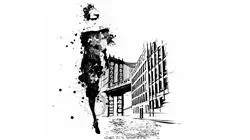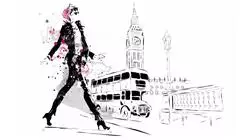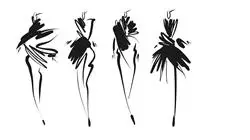University certificate
The world's largest faculty of design”
Introduction to the Program
There is no doubt that fashion influences people's lifestyles. Push yourself even further to design sensational garments that will become must-haves in every closet”

Being a professional fashion designer today requires precise handling of traditional techniques, along with the technological tools that facilitate sketching patterns, even when lacking a proper understanding of graphic design. Learning to concept design expands the ability to express ideas and encourages creative thinking. Therefore, specialized knowledge in the field is essential as it provides everything one needs to know about the market and demand, as well as the most current tools to produce a successful project.
This Postgraduate certificate in Structural and Comprehensive Fashion Design fulfills that need for higher education among designers, offering them an academic program where they can discover the particularities of this booming sector. It does so thanks to a syllabus that covers everything from expressive drawing to composition, garment transformation, packaging and the main applications used in fashion design.
A completely innovative program that understands the needs of today's students and, therefore, focuses on practical teaching as the main learning method. To that end, it offers students multiple exercises and simulated cases that will illustrate real work in the sector through an innovative teaching methodology. Moreover, this course is taught in a 100% online format, so it will be students themselves who self-manage their study time.
Create trendy collections and become part of the fashion design elite”
This Postgraduate certificate in Structural and Comprehensive Fashion Design contains the most complete and up-to-date program the market. Its most notable features are:
- Practical cases presented by experts in fashion
- The graphic, schematic, and practical contents with which they are created provide practical information on the disciplines that are essential for professional practice
- Practical exercises where the self-assessment process can be carried out to improve learning
- Special emphasis on innovative methodologies in fashion design
- Theoretical lessons, questions to the expert, debate forums on controversial topics, and individual reflection assignments
- Content that is accessible from any fixed or portable device with an Internet connection
If you want to reach the level of great designers such as John Galliano or Coco Chanel, don't miss the opportunity to specialize with our program”
Its teaching staff includes professionals from the fashion industry, who bring to this program the experience of their work, as well as renowned specialists from leading societies and prestigious universities.
The multimedia content, developed with the latest educational technology, will provide the professional with situated and contextual learning, i.e., a simulated environment that will provide an immersive training experience designed to train for real-life situations.
This program is designed around Problem Based Learning, whereby the student must try to solve the different professional practice situations that arise during the academic year. For this purpose, the student will be assisted by an innovative interactive video system created by renowned and experienced experts.
TECH offers you a multitude of theoretical and practical resources, thanks to which you can acquire specialized knowledge of the sector"

Reach the pinnacle of the fashion industry and become a benchmark in the sector"
Syllabus
The syllabus for this Postgraduate certificate in Structural and Comprehensive Fashion Design at TECH Global University has been designed with the academic needs of students in this field in mind. Thus, at the end of the program, they will be able to create innovative collections through the use of different techniques and tools that will allow them to create sketches adapted to the needs of target customers that can be faithfully transferred to the fabrics.

Take a first class academic tour through the main techniques and trends in fashion design”
Module 1. Structural and Comprehensive Fashion Design
1.1. Expressive Drawing
1.1.1. Anatomical Structure of the Human Body
1.1.2. Three-Dimensional Space
1.1.3. Perspective and Matrix Analysis
1.2. Visual Semiotics
1.2.1. Color and Light in Three-Dimensional Forms
1.2.2. Contour and Shading
1.2.3. The Movement of Garments in Female and Male Anatomy
1.3. Composition I
1.3.1. Volume
1.3.2. The Female Silhouette and the Male Silhouette
1.3.3. Shape and Negative Shape
1.4. Composition II
1.4.1. Symmetry and Asymmetry
1.4.2. Construction and Deconstruction
1.4.3. Draping and Jewel Embellishments
1.5. Representation Tools
1.5.1. The Geometric Sketch
1.5.2. Rapid Sketching and Poison Techniques
1.5.3. CANVA
1.6. Design Methodology
1.6.1. Computer-Assisted Design
1.6.2. CAD/CAM: Prototypes
1.6.3. Finished Products and Production Runs
1.7. Garment Customization and Transformation
1.7.1. Cutting, Assembling and Finishing
1.7.2. Pattern Adaptations
1.7.3. Garment Customization
1.8. Packaging
1.8.1. Packaging as an Extension of Branding
1.8.2. Sustainable Packaging
1.8.3. Automated Personalization
1.9. Atomic Design
1.9.1. System Components
1.9.2. Templates
1.9.3. Web Designer Typologies
1.10. App Design
1.10.1. Mobile Illustration Techniques
1.10.2. Comprehensive Design Tools: Procreate
1.10.3. Support Tools: Pantone Studio

Know the main techniques used in visual composition and make your sketches display specific garment features”
Postgraduate Certificate in Structural and Integral Fashion Design
.
Structural and integral fashion design is a discipline that focuses on the creation of garments from conception to final production. It is a process that involves several stages, including ideation, design, construction, prototyping, mass production and marketing.
In the early stages of structural and integral fashion design, the aim is to create a clear vision of the garment to determine its style, purpose and target market. This may include researching the latest fashion trends, identifying unique styles and designs, and considering the tastes and needs of the target audience.
As the process progresses, designers create conceptual drawings and designs, which are then transformed into technical patterns. These patterns are the basis for prototyping and creating garments by hand.
Once the garment prototype is ready, it is evaluated in terms of fit and style, and any necessary adjustments are made before mass production begins. This phase may involve working with raw material suppliers, garment manufacturers and other professionals to select the right fabrics, create molds for mass production, and ensure that all garments conform to quality standards.
Finally, marketing the garments involves creating advertising campaigns, organizing fashion events, and working with retailers to bring the garments to market. This is all part of structural and integral fashion design, a discipline that deals with everything from the creation to the marketing of every garment.
At the end of the course, students will be trained in structural and integral fashion design, they will have skills and technical knowledge to devise, design, manufacture and market fashion garments. They will be able to work in different fields of the fashion industry, from haute couture to sustainable fashion.







